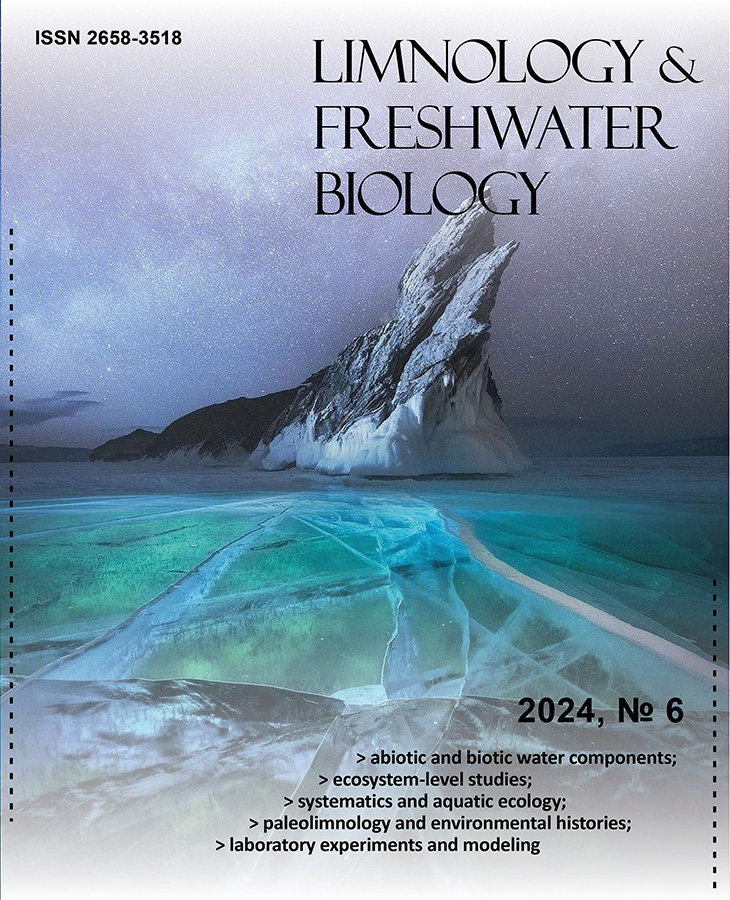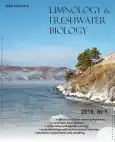Vertical distribution of zooplankton after rapid change in temperature and chlorophyll concentration
- Authors: Makarov M.M.1, Kucher K.M.1, Naumova E.Y.1
-
Affiliations:
- Limnological Institute of the Russian Academy of Sciences
- Issue: No 1 (2019)
- Pages: 177-180
- Section: Articles
- URL: https://journal-vniispk.ru/2658-3518/article/view/283784
- DOI: https://doi.org/10.31951/2658-3518-2019-A-1-177
- ID: 283784
Cite item
Full Text
Abstract
In October 2018, after the change in the temperature profile and chlorophyll concentration, we recorded the changes in the distribution parameters of mesozooplankton in the surface 100 m layer at the station located in the pelagic zone of Lake Baikal. The study was carried out on horizons of 0-50 and 50-100 m. Measurements were performed using an AAQ-Rinko water quality probe (JFE, Japan), a SBE-25 CTD probe (SeaBirdElectronics, USA) and a Furuno FCV-1100 sonar (Furuno, Japan). We found a deepening of zooplankton after the immersion of the chlorophyll and temperature maximum.
About the authors
M. M. Makarov
Limnological Institute of the Russian Academy of Sciences
Author for correspondence.
Email: mmmsoft@hlserver.lin.irk.ru
Siberian Branch
Russian Federation, Ulan-Batorskaya Str., 3, Irkutsk, 664033K. M. Kucher
Limnological Institute of the Russian Academy of Sciences
Email: mmmsoft@hlserver.lin.irk.ru
Siberian Branch
Russian Federation, Ulan-Batorskaya Str., 3, Irkutsk, 664033E. Yu. Naumova
Limnological Institute of the Russian Academy of Sciences
Email: mmmsoft@hlserver.lin.irk.ru
Siberian Branch
Russian Federation, Ulan-Batorskaya Str., 3, Irkutsk, 664033References
- Churilova T.Ya., Moiseeva N.A., Latushkin А.A. et al. 2018. Preliminary results of bio-optical investigations at Lake Baikal. Limnology and Freshwater Biology 1: 58–61. doi: 10.31951/2658-3518-2018-A-1-58
- Fietz S., Kobanova G., Izmest’eva L. et al. 2005. Regional, vertical and seasonal distribution of phytoplankton and photosynthetic pigments in Lake Baikal. Journal of Plankton Research 27: 793–810. doi: 10.1093/plankt/fbi054
- Hampton S.E. 2013. Understanding lakes near and far. Science 342: 815–816.
- Hampton S.E., Gray D.K., Izmest’eva L.R. et al. 2014. The rise and fall of plankton: long-term changes in the vertical distribution of algae and grazers in Lake Baikal, Siberia. PLoS ONE 9. doi: 10.1371/journal.pone.0088920
- Hampton S.E., Izmest’eva L.R., Moore M.V. et al. 2008. Sixty years of environmental change in the in the world’s largest freshwater lake—Lake Baikal, Siberia. Global Change Biology 14: 1947–1958. doi: 10.1111/j.1365-2486.2008.01616.x
- Izmest’eva L.R., Moore M.V., Hampton S.E. et al. 2016. Lake-wide physical and biological trends associated with warming in Lake Baikal. Journal of Great Lakes Research 42: 6–17. doi: 10.1016/j.jglr.2015.11.006
- Kiprushina K.N. 2009. Seasonal dynamics of the zooplankton vertical distribution in the open part of Southern Baikal (near the Bolshiye Koty settlement). The Bulletin of Irkutsk State University. Series “Biology. Ecology” 2: 39–44. (in Russian)
- Mazepova G.F. 1998. The role of copepods in the Baikal ecosystem. Journal of Marine System 15: 113–120. doi: 10.1016/S0924-7963(97)00065-1
- Melnik N.G., Dzyuba E.V., Degtyarev V.A. et al. 2008. Life strategy of pelagic animals in Lake Baikal. Verhandlungen des Internationalen Verein Limnologie [Negotiations of the International Limnology Association] 30: 291–294. doi: 10.1080/03680770.2008.11902129
- Melnik N.G., Sheveleva N.G., Pomazkova G.I. 1998. Distribution of planktonic copepods of Lake Baikal. Journal of Marine System 15: 149–153. doi: 10.1016/S0924-7963(97)00074-2
- Pislegina E.V. 2013. Biomass dynamics of phytoplankton, epishura and copepods in the years of their maximum abundance in the pelagic zone of Southern Baikal. Izvestiya Irkutskogo Gosudarstvennogo Universiteta. Seriya “Biologiya, Ecologiya” [The Bulletin of Irkutsk State University. Series “Biology. Ecology”] 6: 100–104. (in Russian)
- Shimaraeva S.V., Pislegina E.V., Krashchuk L.S. et al. 2017. Dynamics of chlorophyll a concentration in the South Baikal pelagic during the direct temperature stratification period. Inland Water Biology 10: 59–63. doi: 10.1134/S1995082917010163
- Twiss M.R., Ulrich C., Zastepa A. et al. 2012. On phytoplankton growth and loss rates to microzooplankton in the epilimnion and metalimnion of Lake Ontario in mid-summer. Journal of Great Lakes Research 38: 146–153. doi: 10.1016/j.jglr.2012.05.002
- Watkins J.M., Weidel B.C., Rudstam L.G. et al. 2015. Spatial extent and dissipation of the deep chlorophyll layer in Lake Ontario during the Lake Ontario lower food web assessment, 2003 and 2008. Aquatic Ecosystem Health & Management 18:18–27. doi: 10.1080/14634988.2014.937316
Supplementary files










